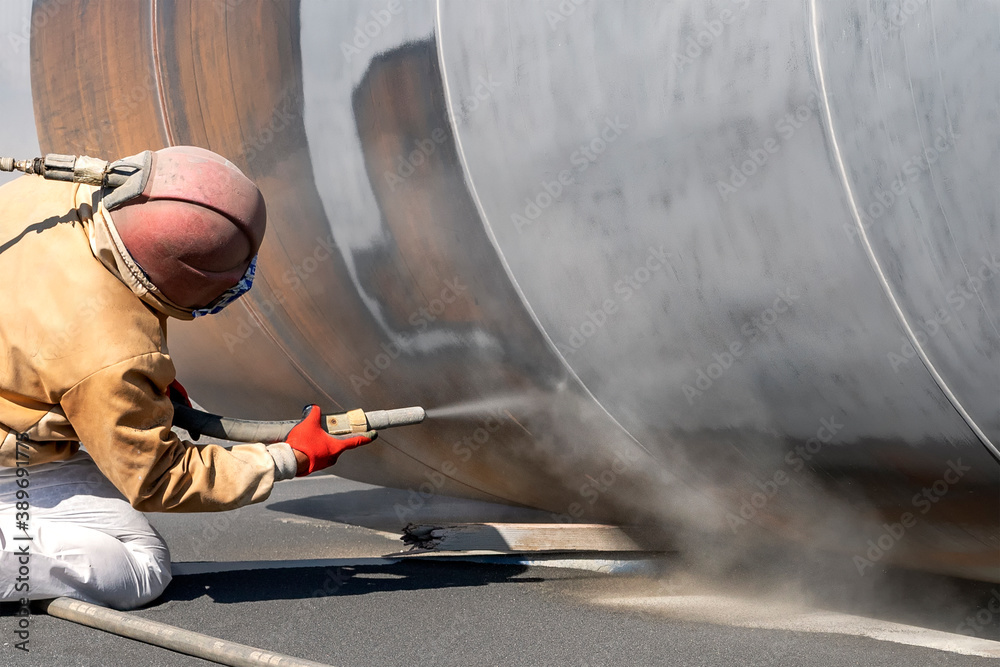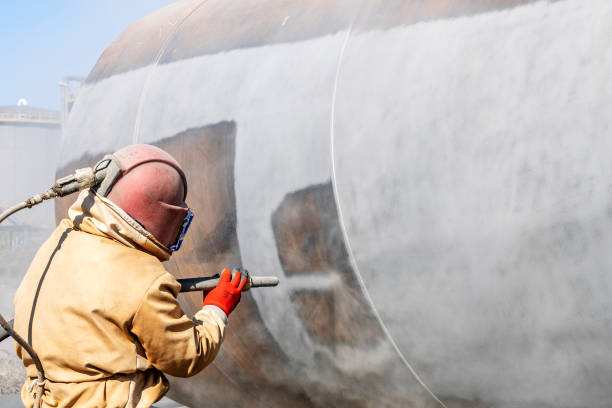Blasting Grit
Global Industries is manufacturer and exporter of Abrasive Powder, Abrasive Grit, Sand Blasting Grit, Steel Grit, Shot Blasting Grit, Abrasive Media, Blasting Sand. We have wide range of sand blasting materials for different applications.
Abrasive grit blasting, or sand blast cleaning, is a surface treatment process widely used in a variety of different industries with many diverse purposes. Abrasive blasting is the process by which an abrasive media is accelerated through a blasting nozzle by means of compressed air. The abrasive used varies based on the surface treatment required.
Size
- G10 - 2.0 mm
- G12 - 1.70 mm
- G14 - 1.40 mm
- G16 – 1.20 mm
- G18 – 1.00 mm
- G25 – 0.710 mm
- G40 – 0.425 mm
- G50 – 0.300 mm
- G80 – 0.180 mm
- Color: Black , Grey Black
- Hardness: 7.5 Mohs
- Density g/cm3: 5.1
- Packing: PP Bags 25 Kgs , 50 Kgs , Big Bag


The range of uses for abrasive grit blasting are very broad and include:
- Removal of burrs or edge profiling machined components
- Providing a matte cosmetic surface finish on consumer products
- Removal of mold flash from plastic components
- Surface texturing of tooling, and molds to alter the appearance of molded or stamped products
- Surface preparation prior to painting, bonding or other coating operations
- Removal of rust, scale, sand, or paint from fabricated components
- Roughening of industrial gas turbine engine component surfaces in preparation for thermal spray coating
Applications
Foundries, Forgings, Ship Builders, Oil and Gas Pipe Line, Hear Treatment Shop, Non Ferrous Castings, Plate Preparation, Railway Wagon & Defense, Automobile Industries, Steel Fabricators and other various type of applications.
What are the Types of Blasting?
Different types of blasting are separated by the types of media they use or the actual process itself (such as automated or wet blasting). Here we present some common forms of abrasive, and non- abrasive, blasting:
Sandblasting
Sandblasting is often used as a generic term for abrasive blasting. This involves the cleaning, smoothing or shaping of a hard surface by striking it with solid particles at high speeds. The effect is similar to that of sandpaper except that it offers a more even finish and can reach into difficult areas. Industrial sandblasting is done using compressed air but can also occur naturally when wind picks up sand particles, leading to Aeolian erosion. Artificial sandblasting was first patented by Benjamin Chew Tilghman on 18 October 1870.
Micro-Abrasive Blasting
Micro-abrasive blasting, also known as pencil blasting, is a dry abrasive process that uses small nozzles to deliver a fine stream of abrasive to a small area or part. The nozzles are typically 0.25- 1.5mm in diameter and the area covered by the blast is just 1mm2 to a few cm2 at the most, with the abrasive media particles being between around 10 and 150 micrometres in size. The abrasive jet is fine and accurate enough to write on glass or cut a pattern in an eggshell, although high pressures are usually required.
Sandblasting
Sandblasting is often used as a generic term for abrasive blasting. This involves the cleaning, smoothing or shaping of a hard surface by striking it with solid particles at high speeds. The effect is similar to that of sandpaper except that it offers a more even finish and can reach into difficult areas. Industrial sandblasting is done using compressed air but can also occur naturally when wind picks up sand particles, leading to Aeolian erosion. Artificial sandblasting was first patented by Benjamin Chew Tilghman on 18 October 1870.
Bead Blasting
Bead blasting uses fine glass beads to clean away deposits from surfaces, remove paint or other applications where a uniform finish is required for machined parts. Widely used in the automotive industry, bead blasting is also used to clean mineral specimens with a Mohs hardness of seven or less and would thereby be damaged by harsher sandblasting methods.
Wet Abrasive Blasting
Wet abrasive blasting was developed as an alternative to dry blasting, using a fluid (typically water) to help propel the abrasive media at the workpiece. The water offers the advantage of trapping dust and lubricating the surface as well as cushioning the impact of the abrasives and thereby reducing the unwanted removal of underlying materials. Wet abrasive blasting can be undertaken with portable equipment or blast cabinets and blast rooms. It can also be automated and delivers advantages including the ability to use both fine or coarse media ranging from plastic to steel. The reduction in dust makes it safer for use with siliceous materials and for the removal of hazardous materials like asbestos, radioactive or poisonous products. Wet blasting can also use hot water and soap to allow for simultaneous degreasing during the blasting process.
Wet blasting is not as fast as dry blasting when using a comparative size and type of abrasive material. This is due to the liquid creating a lubricating cushion between the abrasive and the substrate, protecting the surface and reducing breakdown rates. However, with a reduced impact on the surface, dust reduction and the elimination of static cling, wet blasting can create very clean surfaces. The lack of surface recontamination means that the same equipment can be used for different blasting operations, although blasting mild steel will create immediate ‘flash’ corrosion on the surface of the steel substrate due to the presence of water.
Wheel Blasting
Wheel blasting uses a spinning wheel to propel the abrasive at an object. This is an ‘airless’ operation since no gas or liquid propellant is used. The size and number of blast wheels varies depending on the required results of the process. Wheel blasting is typically performed in a chamber where the abrasive can be recycled, with media including steel or stainless steel shot, cut wire, grit, or similarly sized pellets being used. Blast machines can be used to propel plastic abrasives for deflashing rubber and plastic components. The blast wheel was first patented in 1932 by Wheelabrator, and the first blast wheel was built in China in the 1950s.
Vacuum Blasting
Vacuum blasting offers the advantage of generating very little dust and spill, since the blast tool simultaneously blasts and collects used media and loose particles. Because the media is automatically separated from the dust and loose particles it can be reused several times, reducing blast media consumption.
Hydro-Blasting
Also known as water blasting, hydro blasting is not a form of abrasive blasting since no abrasive materials are used. Instead, the process uses a high-pressure jet of water to remove old paint, chemicals or other build-ups without damaging the surface of the workpiece. Hydro blasting has the benefit of reaching difficult to reach areas as well as reducing waste by recapturing the water and using it again.
Bristle Blasting
Unlike other blasting methods, bristle blasting does not use a separate blast media, instead using a brush-like rotary tool made from dynamically-tuned high-carbon steel wire. The rotating bristle tips create a localised impact, rebound and crater formation to clean and coarsen surfaces.
Automated Blasting
Automated blasting is the automation of a blasting process rather than a specific process in its own right. It is often part of a larger automated procedure that can involve other surface treatments like coating and preparation. Automated blasting can be part of a wider production process whereby a production line of similar parts are delivered to the blasting chamber in succession.